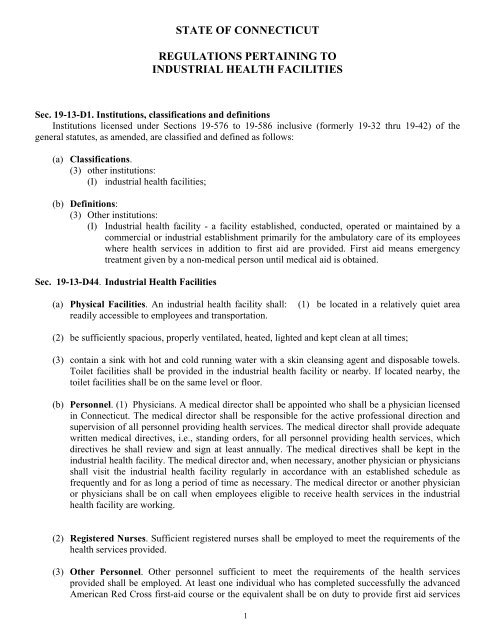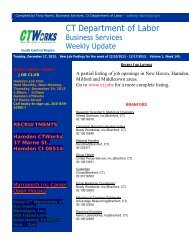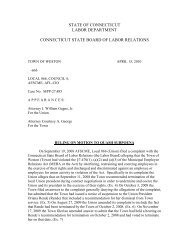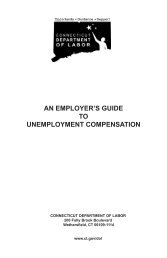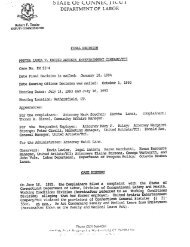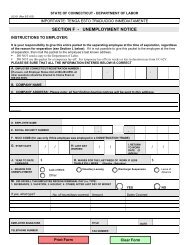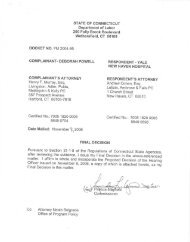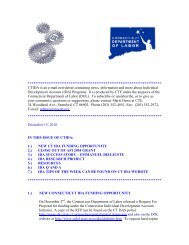state of connecticut regulations pertaining to industrial health facilities
state of connecticut regulations pertaining to industrial health facilities
state of connecticut regulations pertaining to industrial health facilities
You also want an ePaper? Increase the reach of your titles
YUMPU automatically turns print PDFs into web optimized ePapers that Google loves.
STATE OF CONNECTICUT<br />
REGULATIONS PERTAINING TO<br />
INDUSTRIAL HEALTH FACILITIES<br />
Sec. 19-13-D1. Institutions, classifications and definitions<br />
Institutions licensed under Sections 19-576 <strong>to</strong> 19-586 inclusive (formerly 19-32 thru 19-42) <strong>of</strong> the<br />
general statutes, as amended, are classified and defined as follows:<br />
(a) Classifications.<br />
(3) other institutions:<br />
(I) <strong>industrial</strong> <strong>health</strong> <strong>facilities</strong>;<br />
(b) Definitions:<br />
(3) Other institutions:<br />
(I) Industrial <strong>health</strong> facility - a facility established, conducted, operated or maintained by a<br />
commercial or <strong>industrial</strong> establishment primarily for the ambula<strong>to</strong>ry care <strong>of</strong> its employees<br />
where <strong>health</strong> services in addition <strong>to</strong> first aid are provided. First aid means emergency<br />
treatment given by a non-medical person until medical aid is obtained.<br />
Sec. 19-13-D44. Industrial Health Facilities<br />
(a) Physical Facilities. An <strong>industrial</strong> <strong>health</strong> facility shall: (1) be located in a relatively quiet area<br />
readily accessible <strong>to</strong> employees and transportation.<br />
(2) be sufficiently spacious, properly ventilated, heated, lighted and kept clean at all times;<br />
(3) contain a sink with hot and cold running water with a skin cleansing agent and disposable <strong>to</strong>wels.<br />
Toilet <strong>facilities</strong> shall be provided in the <strong>industrial</strong> <strong>health</strong> facility or nearby. If located nearby, the<br />
<strong>to</strong>ilet <strong>facilities</strong> shall be on the same level or floor.<br />
(b) Personnel. (1) Physicians. A medical direc<strong>to</strong>r shall be appointed who shall be a physician licensed<br />
in Connecticut. The medical direc<strong>to</strong>r shall be responsible for the active pr<strong>of</strong>essional direction and<br />
supervision <strong>of</strong> all personnel providing <strong>health</strong> services. The medical direc<strong>to</strong>r shall provide adequate<br />
written medical directives, i.e., standing orders, for all personnel providing <strong>health</strong> services, which<br />
directives he shall review and sign at least annually. The medical directives shall be kept in the<br />
<strong>industrial</strong> <strong>health</strong> facility. The medical direc<strong>to</strong>r and, when necessary, another physician or physicians<br />
shall visit the <strong>industrial</strong> <strong>health</strong> facility regularly in accordance with an established schedule as<br />
frequently and for as long a period <strong>of</strong> time as necessary. The medical direc<strong>to</strong>r or another physician<br />
or physicians shall be on call when employees eligible <strong>to</strong> receive <strong>health</strong> services in the <strong>industrial</strong><br />
<strong>health</strong> facility are working.<br />
(2) Registered Nurses. Sufficient registered nurses shall be employed <strong>to</strong> meet the requirements <strong>of</strong> the<br />
<strong>health</strong> services provided.<br />
(3) Other Personnel. Other personnel sufficient <strong>to</strong> meet the requirements <strong>of</strong> the <strong>health</strong> services<br />
provided shall be employed. At least one individual who has completed successfully the advanced<br />
American Red Cross first-aid course or the equivalent shall be on duty <strong>to</strong> provide first aid services<br />
1
whenever a registered nurse or a physician is not on duty in the <strong>industrial</strong> <strong>health</strong> facility and<br />
employees eligible <strong>to</strong> receive services are working in the commercial or <strong>industrial</strong> establishment.<br />
(c) Equipment. Equipment adequate for the number <strong>of</strong> employees <strong>to</strong> be served and the types <strong>of</strong> <strong>health</strong><br />
services <strong>of</strong>fered shall be provided.<br />
(d) Supplies. Supplies adequate for the number <strong>of</strong> employees <strong>to</strong> be served and the types <strong>of</strong> <strong>health</strong><br />
services <strong>of</strong>fered shall be provided.<br />
(e) Medical Records. (1) Completeness. A medical record shall be started for each individual who<br />
receives <strong>health</strong> services. The medical record shall contain all medical and <strong>health</strong> related reports and<br />
letters received from labora<strong>to</strong>ries, physicians and others. An entry shall be made for every visit <strong>of</strong><br />
such person <strong>to</strong> the <strong>industrial</strong> <strong>health</strong> facility. All treatments administered shall be recorded, dated and<br />
signed by the individual who administered the treatment. A daily statistical record shall be kept <strong>of</strong><br />
the services provided in the <strong>industrial</strong> <strong>health</strong> facility and kept for at least eighteen months.<br />
(2) Confidentiality. Medical records shall be confidential except for cases involving claims under the<br />
Workmens' Compensation Act and except that the medical direc<strong>to</strong>r shall disclose or authorize the<br />
disclosure <strong>of</strong> information as required by law and may disclose or authorize the disclosure <strong>of</strong><br />
information <strong>to</strong> responsible individuals when he believes such disclosure is necessary for the best<br />
interest <strong>of</strong> the employee, or when written consent is received from the employee.<br />
(3) S<strong>to</strong>rage and Security. All current medical records shall be kept in locked files in the <strong>industrial</strong><br />
<strong>health</strong> facility under control <strong>of</strong> the medical direc<strong>to</strong>r. Noncurrent medical records and medical<br />
records regarding former employees shall be kept in locked files under control <strong>of</strong> the medical<br />
direc<strong>to</strong>r for at least three years.<br />
(f) X-ray Services. If diagnostic x-ray services are provided in the <strong>industrial</strong> <strong>health</strong> facility, the<br />
requirements <strong>of</strong> the public <strong>health</strong> code shall be complied with. The x-ray equipment shall be<br />
operated by adequately trained individuals. No x-ray examination shall be performed unless<br />
specifically ordered by a physician.<br />
(g) Drugs. (1) Definitions. (A) “Administer” means <strong>to</strong> give, distribute, leave with, or deliver drugs <strong>to</strong><br />
an employee in amounts <strong>to</strong> satisfy the needs <strong>of</strong> the employee for a time period not greater than the<br />
number <strong>of</strong> hours in the employees' work shift. (B) “Controlled drug” means a controlled drug as<br />
defined in section 19-443 (6) <strong>of</strong> the 1969 supplement <strong>to</strong> the general statutes. (C) “Dispense” means<br />
<strong>to</strong> give, distribute, leave with or deliver drugs <strong>to</strong> an employee in amounts <strong>to</strong> satisfy the needs <strong>of</strong> the<br />
employee for a time period greater than the number <strong>of</strong> hours in the work shift. (D) “Manufacturer <strong>of</strong><br />
drugs” means a person who has complied with <strong>state</strong> and federal requirements regarding the<br />
manufacture <strong>of</strong> drugs. (E) “Narcotic drug” means a narcotic drug as defined in section 19-433 (18)<br />
<strong>of</strong> the 1969 supplement <strong>to</strong> the general statutes. (F) “Prescription drug” means a drug which is not<br />
permitted by federal drug laws <strong>to</strong> be sold, administered or dispensed without a prescription or<br />
written order from a licensed practitioner. (G) “Licensed pharmacy” means a pharmacy licensed in<br />
accordance with the provisions <strong>of</strong> chapter 382 <strong>of</strong> the general statutes. (H) “Wholesaler <strong>of</strong> drugs”<br />
means a person who has complied with the <strong>state</strong> and federal requirements regarding the wholesaling<br />
<strong>of</strong> drugs.<br />
2
(2) Procurement. Prescription drugs, including non-narcotic controlled drugs, for use in an <strong>industrial</strong><br />
<strong>health</strong> facility shall be purchased or obtained by the medical direc<strong>to</strong>r from a wholesaler or<br />
manufacturer <strong>of</strong> drugs. In an emergency, prescription drugs, including non-narcotic controlled<br />
drugs, may be purchased or obtained from a licensed pharmacy. Narcotic drugs for use in an<br />
<strong>industrial</strong> <strong>health</strong> facility shall be purchased or obtained by the medical direc<strong>to</strong>r from a manufacturer<br />
or wholesaler <strong>of</strong> drugs on an <strong>of</strong>ficial narcotic order form. The medical direc<strong>to</strong>r shall register with<br />
the internal revenue service and obtain a Class 4 narcotic tax stamp with the address <strong>of</strong> the<br />
<strong>industrial</strong> <strong>health</strong> facility.<br />
(3) Administration. Nonprescription drugs may be administered by a physician, a registered nurse, a<br />
licensed practical nurse or an individual who has completed successfully the advanced American<br />
Red Cross first aid course or the equivalent in accordance with a written general medical directive<br />
from the medical direc<strong>to</strong>r, or in accordance with a specific written or oral order from a physician for<br />
a specific patient. Prescription drugs, including narcotic and other controlled drugs, may be<br />
administered by a physician, or by a registered nurse in accordance with a specific oral or written<br />
order from a physician for a specific patient. A registered nurse may, in an emergency, administer a<br />
prescription drug in accordance with a general written medical directive from the medical direc<strong>to</strong>r.<br />
The physician shall confirm a verbal order in writing on the patient's medical record. Written orders<br />
shall be filed in the patient's medical record. Only a physician or registered nurse may administer<br />
drugs intramuscularly. Only a physician may administer drugs intravenously.<br />
(4) Dispensing. Drugs may be dispensed by a physician. A drug or drugs dispensed by a registered<br />
nurse, when ordered by a physician orally or in writing <strong>to</strong> dispense a drug or drugs <strong>to</strong> a specific<br />
patient, shall be construed <strong>to</strong> have been dispensed by the physician. The physician shall confirm a<br />
verbal order in writing on the patient's medical record. Written orders shall be filed with the<br />
patient's medical record.<br />
(5) Records. (A) Controlled drugs, including narcotics. A record separate from the medical records<br />
shall be kept <strong>of</strong> controlled drugs purchased or received and administered or dispensed. The record<br />
shall in each case show the date <strong>of</strong> receipt, the name and address <strong>of</strong> the person from whom received<br />
and the kind and quantity received. The record shall show the date and time <strong>of</strong> administration,<br />
dispensing or disposal, the name <strong>of</strong> the person <strong>to</strong> whom administered, dispensed or disposed, and<br />
the kind and quantity <strong>of</strong> drug, the name <strong>of</strong> the physician who ordered the drug administered or<br />
dispensed and the name <strong>of</strong> the individual who administered or dispensed the drug. Each such record<br />
shall be separately maintained and kept for a period <strong>of</strong> three years from the date <strong>of</strong> the transaction<br />
recorded. The keeping <strong>of</strong> a record required by or under federal drug laws containing essentially the<br />
same information as is specified above shall constitute compliance with this subsection, provided<br />
each record shall, in addition, contain a detailed list <strong>of</strong> any controlled drugs lost, destroyed or<br />
s<strong>to</strong>len, the kind and quantity <strong>of</strong> such drugs and the date <strong>of</strong> the discovery <strong>of</strong> such loss, destruction or<br />
theft. A notation regarding the kind and dosage <strong>of</strong> each controlled drug administered or dispensed <strong>to</strong><br />
an employee shall be made in the employee's medical record. This shall be signed and dated by the<br />
individual who administered or dispensed the drug. An annual inven<strong>to</strong>ry <strong>of</strong> narcotic drugs shall be<br />
prepared in June and filed with the internal revenue service and the Class 4 narcotic tax stamp shall<br />
be renewed during June. (B) Prescription drugs other than controlled drugs. A notation regarding<br />
the kind and dosage <strong>of</strong> each prescription drug other than a controlled drug, administered or<br />
dispensed <strong>to</strong> an employee shall be made in the employee's medical record. This shall be signed and<br />
dated by the individual who administered or dispensed the drug. (C) Nonprescription drugs. A<br />
notation regarding the kind and dosage <strong>of</strong> each nonprescription drug administered or dispensed <strong>to</strong><br />
an employee shall be made in the employee's medical record. This notation shall be signed and<br />
dated by the individual who administered or dispensed the drug.<br />
3
(6) S<strong>to</strong>rage. (A) Narcotic drugs. Class A and B narcotic drugs not in excess <strong>of</strong> twelve taxable items<br />
shall be s<strong>to</strong>red in a strong locked non-portable container in a locked medicine cabinet. Keys <strong>to</strong> the<br />
container shall be kept separate from the keys <strong>to</strong> the cabinet and such keys shall be kept only by a<br />
physician or a registered nurse. Class A and B narcotic drugs in excess <strong>of</strong> twelve taxable items shall<br />
be kept in an approved chest or safe. Class X narcotic drugs shall be s<strong>to</strong>red in the same manner as<br />
other prescription drugs. (B) Prescription drugs excluding Class A and B narcotic drugs.<br />
Prescription drugs excluding Class A and B narcotic drugs shall be s<strong>to</strong>red in a medicine cabinet.<br />
The cabinet shall be locked when neither a physician nor a registered nurse is in attendance in the<br />
<strong>industrial</strong> <strong>health</strong> facility. Keys <strong>to</strong> the medicine cabinet shall be kept only by a physician or a<br />
registered nurse. (C) Nonprescription drugs. Nonprescription drugs shall be s<strong>to</strong>red in a locked<br />
medicine cabinet when no one is in attendance in the <strong>industrial</strong> <strong>health</strong> facility.<br />
(7) Labeling. Drugs may be repackaged for s<strong>to</strong>ck by a physician. Drugs repackaged for s<strong>to</strong>ck by a<br />
registered nurse under the direction and supervision <strong>of</strong> a physician shall be construed <strong>to</strong> have been<br />
repackaged by a physician. The proper label shall be affixed <strong>to</strong> the container containing repackaged<br />
s<strong>to</strong>ck drugs. The container in which a drug is dispensed shall contain a label with the name <strong>of</strong> the<br />
patient, name <strong>of</strong> the drug, strength <strong>of</strong> the drug, directions for use, name <strong>of</strong> the prescribing physician,<br />
the date <strong>of</strong> dispensing and the precautions, if any, <strong>to</strong> be taken. The name <strong>of</strong> the drug and the<br />
strength may be deleted from the label if the label contains a code number or some other device by<br />
which the individual dispensing the drug can identify it.<br />
(8) Additional Requirements. Additional requirements which the commissioner <strong>of</strong> <strong>health</strong> may<br />
prescribe regarding safeguarding and handling <strong>of</strong> drugs in special cases shall be complied with.<br />
(h) Discontinuation. The administra<strong>to</strong>r <strong>of</strong> the <strong>industrial</strong> <strong>health</strong> facility shall notify the commissioner <strong>of</strong><br />
labor at least fifteen days prior <strong>to</strong> discontinuation <strong>of</strong> operation <strong>of</strong> an <strong>industrial</strong> <strong>health</strong> facility <strong>to</strong><br />
assure proper disposal <strong>of</strong> drugs and potentially hazardous equipment and proper disposition <strong>of</strong><br />
medical records.<br />
4


